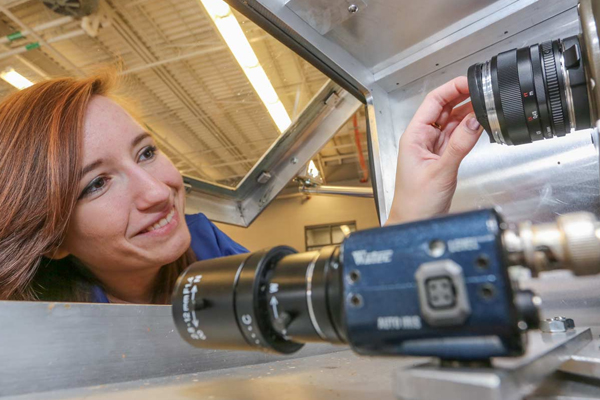Lightning Strikes Still Pose Mysteries To Researchers

Lightning strike. (Credit: Brandon Morgan)
Though lightning has been studied extensively over the years, there are many questions that researchers need to answer. For example, there is still some debate as to how lightning forms in the first place. Scientists at the University of Alabama – Huntsville are attacking that question and more in ongoing studies into lightning strikes at the university’s Earth System Science Center.
These efforts make sense, as lightning is one of Earth’s most common weather phenomena. About 46 flashes can be seen somewhere on our planet nearly every second. That works out to four million times a day and 1.4 billion lightning strikes every year.
To study lightning, from how often it occurs and where to finer details relating to the physics of how each lightning strike forms, the U. of Alabama investigators use a number of tools. The most prominent include a lightning imaging sensor they’ve helped develop, which is currently mounted on NASA’s Tropical Rainfall Measuring Mission satellite, and a terrestrial array deployed in a network around campus.
The lightning imaging sensor has been flying on the low-Earth orbit satellite for more than 17 years. It records lightning strikes as they flash beneath it, covering the tropics and the subtropics and areas north and south of the Equator to 30 degrees latitude.

Jacquelyn Ringhausen checks two cameras, one regular and one high speed, used for video of lightning and spectroscopy. (Credit: Michael Mercier / University of Alabama – Huntsville)
All the data have helped to reveal some of the key lightning dynamics at play around the world. Scientists have uncovered that their previous estimates of lightning strikes, placed at around 100 strikes per second, were massively overdone. The real figure, 1.4 billion each year, was captured by the imaging sensor.
In addition, researchers have pinpointed where most of the lightning on Earth takes place. There are high levels of lightning activity over several large lakes, including Lake Maricaibo in Venezuela and Lake Victoria in Africa. Maracaibo earns the title of the world’s lightning hotspot, with lightning occurring there 297 days a year.
Most lightning takes place during the day because heat from the sun causes convection, essentially circulation that transfers heat. But Lake Maricaibo’s case is rare. Much of its nearby lightning flashes at night because of the warmth of its waters. Wind flows at its surface converge, creating rising motions that help create ideal conditions for lightning. Other lakes, like Lake Victoria, also have warmer waters that can help to spur lightning at night.
The Congo River basin was once thought to be the hottest lightning location on Earth. But data from the imaging sensor, used in a global lightning grid with high resolution, ruled that out. This showed that Lake Maracaibo has about 232.5 lightning flashes per kilometer each year. The next most active spot was near Kabare, in the Democratic Republic of Congo, with 205.3 lightning flashes per year. In the continental United States, the hotspot is over the Everglades near Fort Myers, Fla., coming in at 79 flashes every year.
Additional lightning imaging sensors are planned to be launched in the coming months. One is scheduled to be mounted on the International Space Station and another is to be launched aboard a new National Oceanic and Atmospheric Administration weather satellite.
In the future, data collected by the imaging sensors will help U. of Alabama researchers break down flashes into their smallest pieces and work to build new ways to forecast severe weather. Scientists are looking to focus on the more fundamental aspects of lightning to see how strikes change and how the shifts are related to parent storms.

Phillip Bitzer, assistant professor of atmospheric science at University of Alabama – Huntsville, displays a lightning sensor on the roof of the National Space Science Technology Center. A still camera is also installed to provide time-lapse photos of weather viewable on the web. (Credit: Michael Mercier / University of Alabama – Huntsville)
The terrestrial marx meter array that U. of Alabama – Huntsville has on campus has a different role than the satellite-mounted imaging sensors. Instead of photographing the instances of lightning, it tracks changes in electrical fields that lightning makes. After it’s converted to a voltage, researchers can use the data to draw conclusions.
The network has helped scientists to better estimate the strength of lightning strikes and the locations of different processes during the startup of flashes, a period known as initiation. This typically takes place about 30 milliseconds before the actual strike and is marked by descending electrical leaders that meet with others coming up from the Earth’s surface to form a pathway.
But as for pinpointing the actual point at which a lightning strike occurs, they haven’t gotten there yet. Investigators know that lightning is caused by a buildup of positive and negative electrical charges inside a cloud. These separate in a thunderstorm updraft to produce the electric field necessary to produce lightning. However, researchers have yet to measure an electric field sufficiently strong to initiate a lightning strike — that’s a missing step they’ve yet to identify.
Top image: Lightning strike. (Credit: Brandon Morgan / Public Domain)




0 comments